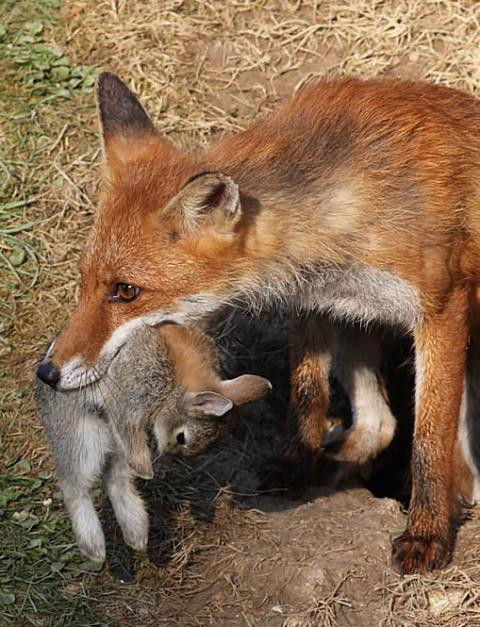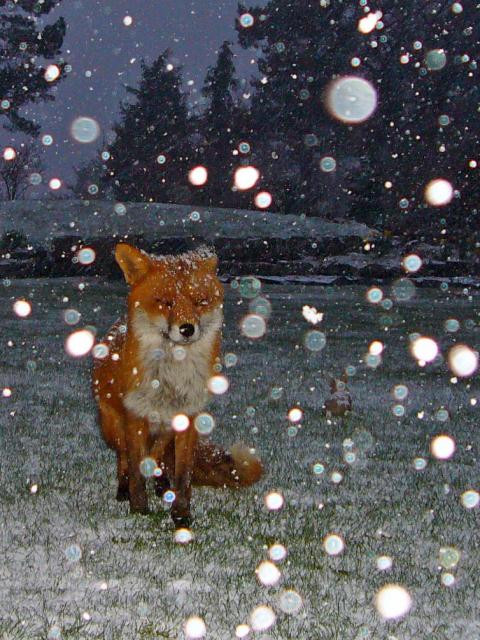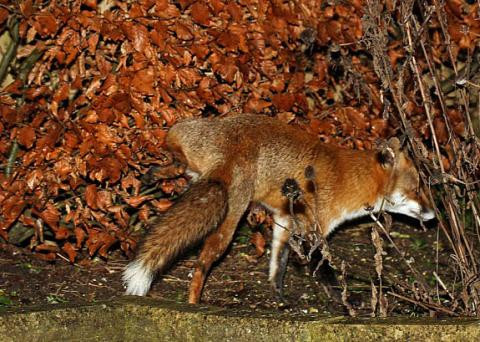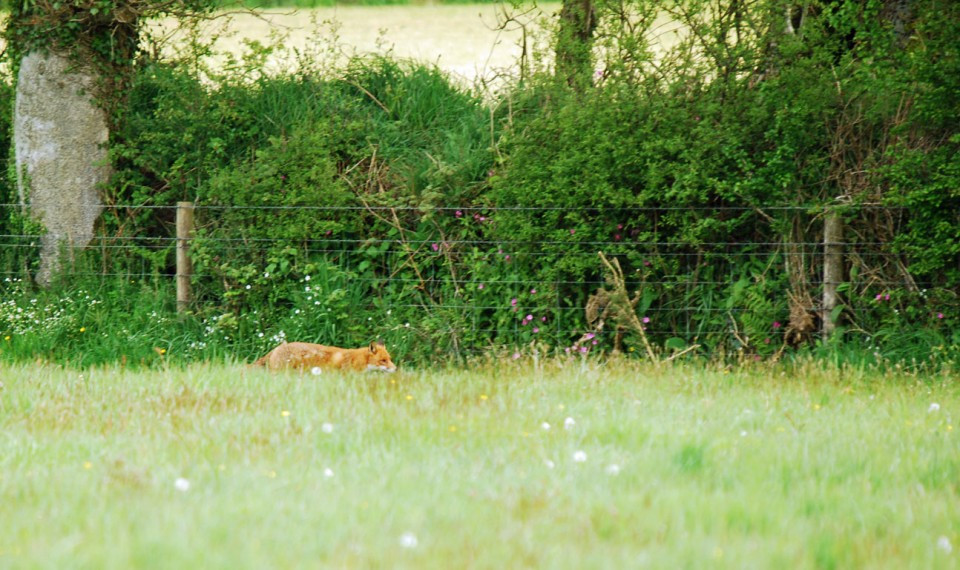Do you want to explore the fascinating world of foxes and their roaming habits during your trip to Vietnam? SIXT.VN is here to guide you through the secrets of their territorial behavior and the distances they cover, enhancing your wildlife encounters in Vietnam. Discover the distances foxes travel and what this reveals about their behavior, and plan your tours to observe these amazing creatures with ease.
1. Understanding Fox Home Ranges: An Overview
How Far Do Foxes Travel From Their Den? Foxes’ travel distances vary greatly depending on factors like food availability, habitat, and mating season, and these distances typically range from a few hectares in urban settings to thousands of hectares in sparsely populated areas. Let’s delve into the fascinating details of fox home ranges, exploring what influences their movements and territorial behaviors. Understanding these aspects can enrich your wildlife tours in Vietnam, offering deeper insights into the ecological dynamics of the region.
1.1. Defining Home Range and Territory
The home range of a fox is the area it roams in search of food, water, and shelter, while a territory is the defended portion of that home range. These terms are essential in understanding fox behavior and how they interact with their environment. According to research from the Wildlife Conservation Research Unit in 1987, home ranges can overlap among different foxes, but territories are generally exclusive. Understanding these concepts helps tourists appreciate the complexities of local ecosystems.
1.2. Factors Influencing Territory Size
The size of a fox’s territory is primarily influenced by the distribution of resources, particularly food. Abundant resources allow for smaller territories, while scarce resources necessitate larger ranges. This relationship is confirmed by a study published in the Journal of Animal Ecology in 2005, which highlighted that foxes in resource-rich environments could maintain smaller territories. During your exploration of Vietnam, remember that local foxes’ territory size may reflect the area’s natural abundance.
1.3. Seasonal Variations in Territory Use
Foxes’ territory use changes with the seasons, with the breeding season prompting the most extensive travel. During winter, male foxes especially increase their range to find mates. The seasonal shifts are crucial for understanding fox behavior and optimizing wildlife viewing experiences. The breeding season sees males traveling far and wide, often beyond their usual territories, in search of mates.
2. How Far Do Foxes Travel in Different Habitats?
The distance a fox travels from its den is significantly influenced by its habitat. Urban foxes generally have smaller territories due to concentrated food sources, whereas rural foxes need larger areas to forage. When planning your sightseeing tours, keep in mind that the habitat greatly affects how foxes behave and where they are likely to be seen.
2.1. Urban vs. Rural Territories
Urban foxes may only roam within a few hectares, thanks to readily available food from human sources. Rural foxes, however, might need hundreds or even thousands of hectares to secure their resources. This contrast is supported by studies in the Journal of Urban Ecology in 2012, which compared urban and rural fox behaviors, highlighting the adaptability of foxes to different environments.
2.2. Examples of Territory Sizes
To illustrate, territories in urban Oxford averaged about 90 hectares, while those in Dutch heathland could extend to 880 hectares. In extreme cases, such as desert regions, a fox’s territory might cover up to 5,000 hectares. These specific examples, documented by David Macdonald in “Running with the Fox” in 1987, illustrate the diversity in fox territorial behavior based on habitat.
Here’s a summary of typical territory sizes:
| Habitat Type | Average Territory Size (ha) |
|---|---|
| Urban Gardens/Farmland | 10-70 |
| Mixed Farmland | 100-250 |
| Deciduous Woodland | 20-100 |
| Suburban Areas | 25-90 |
| Dutch Heathland | 880 |
2.3. Habitat and Territory Exclusivity
Habitat type also affects how strictly foxes defend their territories. In urban areas, territories are clearly defined and meticulously observed, whereas rural areas may see more overlapping and tolerance. As observed by Macdonald, habitat greatly influences the territorial behavior of foxes.
 Fox with a rabbit at its den, illustrating resource availability affecting territory size
Fox with a rabbit at its den, illustrating resource availability affecting territory size
3. Territorial Behavior: Defense and Communication
Understanding how foxes defend and communicate within their territories provides insights into their social structures and behaviors. Communication methods include scent marking and vocalizations, crucial for maintaining territory boundaries. This section will help you appreciate the complex interactions among foxes.
3.1. Scent Marking and Communication
Foxes use scent marking, primarily through urine and scat, to define their territories. These scent marks communicate a wealth of information, including the fox’s sex, health, and social status. According to research in the Journal of Chemical Ecology in 2010, scent marking is essential for territorial maintenance and communication.
3.2. Territory Defense Mechanisms
Foxes defend their territories against intruders, with larger males often having an advantage. These defense mechanisms can range from scent marking to physical confrontations. Research from the Journal of Mammology in 2008 indicates that larger male foxes tend to hold larger territories and are more capable of defending them.
3.3. Recognizing Neighbors
Foxes can recognize their neighbors, which helps reduce unnecessary conflicts. Recognizing familiar scents and calls helps maintain peace within the community. A study in Animal Behaviour in 2011 demonstrated that foxes react differently to familiar and unfamiliar scents, suggesting neighbor recognition.
4. Non-Territorial Foxes: Itinerants and Floaters
Not all foxes maintain territories; some are itinerant, roaming without a fixed home range, while others are floaters, occupying border zones between territories. These non-territorial behaviors offer a different perspective on fox social dynamics.
4.1. Defining Itinerant Foxes
Itinerant foxes, making up about 15% of the adult fox population, wander without a fixed home range. These foxes may travel long distances and behave differently from territory holders. Andrew Wilson’s studies in the mid-1990s showed that itinerants use their habitat differently than territorial foxes.
4.2. Behavior of Floaters
Floaters are juvenile foxes that have failed to establish territories and occupy the border zones between established territories. These foxes typically have smaller activity areas. According to Ad Vos in the Journal of Veterinary Medicine in 2003, floaters have reduced activity areas and occupy border zones.
4.3. Advantages and Disadvantages
The non-territorial lifestyle has advantages and disadvantages. While itinerant foxes avoid the energy expenditure of territory defense, they may face challenges in accessing resources. Understanding these dynamics offers insight into the adaptability of foxes.
5. Seasonal Variation: Breeding and Food Availability
Seasonal changes, particularly breeding season and food availability, significantly influence how far foxes travel. These variations affect territory use and daily movement patterns. Knowing these patterns can help you better plan your sightseeing tours for optimal wildlife viewing.
5.1. Breeding Season Movements
During the breeding season, male foxes increase their movements to find mates, often trespassing into neighboring territories. These behaviors are essential for understanding fox mating strategies. According to studies in North America, male foxes may increase their nightly movements by four to eight times during the breeding season.
5.2. Food Availability and Territory Use
The availability of food impacts how foxes use their territory. During times of abundance, such as when fruits are plentiful, foxes may move less. Tsukada’s research in the Journal of Ethology in 1997 showed that foxes adjust their territorial behavior based on food distribution.
5.3. Impact on Daily Movements
Seasonal changes influence the distance foxes travel each night. Adverse weather conditions, such as snow cover, can also reduce travel distances. These factors help explain variations in fox activity patterns.
 Fox in the snow, illustrating winter breeding season movements
Fox in the snow, illustrating winter breeding season movements
6. Individual Fox Movements: Patrols and Drifting
Individual fox movements, including nightly patrols and territory drifting, reveal how foxes manage and maintain their spaces. This section helps you understand the dynamic nature of fox territories.
6.1. Nightly Patrols
Foxes often follow well-defined paths during their nightly activities, patrolling their territory borders. These patrols are essential for maintaining territorial boundaries. Researchers have found that foxes focus most of their activity in core areas of their range, such as breeding earths or hunting grounds.
6.2. Territory Drifting
In some urban environments, fox territories may drift due to disturbances like construction and traffic. This phenomenon highlights the adaptability of foxes to changing landscapes. Macdonald and Doncaster’s studies in Oxford demonstrated that territories drifted in synchrony due to urban disturbances.
6.3. Response to Environmental Changes
Fox populations respond to environmental changes, such as disease outbreaks, by expanding or reorganizing their territories. The appearance of sarcoptic mange in Bristol led to significant changes in territory sizes and configurations.
7. How Foxes Use Their Paws: Distances and Dispersal
How far do foxes travel from their den? The distances foxes travel depend on their ability to move efficiently within their territories, with studies showing varied nightly ranges depending on the environment. Additionally, the dispersal distances of foxes can be quite extensive, reflecting their adaptability and search for new territories.
7.1. Average Nightly Distances
Generally, foxes move roughly the same distance each night, although adverse weather conditions may reduce this. In Bristol, foxes moved an average of eight kilometers per night. Similar values have been recorded in Japan and Spain.
7.2. Record-Breaking Distances
There are cases of foxes traveling remarkable distances, such as “Fleet” in the UK, who traveled 315 km in just under one month. These long-distance movements demonstrate the dispersal capabilities of foxes.
7.3. Dispersal Strategies
Foxes employ various dispersal strategies to establish new territories. These strategies include exploring new areas and, in some cases, returning to previously explored locations. Walton’s research in the European Journal of Wildlife Management in 2018 highlights the mobility and dispersal capability of foxes.
8. Marking Territory: The Scent of Home
Foxes use scent marking to communicate occupancy, leaving urine and scat at strategic sites throughout their territory. This behavior is essential for maintaining boundaries and signaling to other foxes.
8.1. Types of Scent Marks
Droppings and urine are the most common forms of territory markers. Foxes deposit these scent marks on conspicuous objects to make their presence known. Research indicates that foxes frequently leave droppings on visually conspicuous objects such as rocks and garden gnomes.
8.2. Information Conveyed by Scent
Fox scent marks contain a wealth of information about the individual, including their sex, season, relatedness, and health. Janosch Arnold’s work at Bristol University revealed that fox scent marks communicate important details about the animal who left it.
8.3. Responding to Alien Scents
Foxes respond to alien urine by increasing their activity in the area where the scent was detected, often searching for the intruder. This behavior underscores the importance of scent in territorial defense. Arnold, Soulsbury, and Harris reported in the Canadian Journal of Zoology in 2011 that foxes change their behavior when encountering unfamiliar urine in their territory.
 Fox cocking its leg to urinate, illustrating scent marking behavior
Fox cocking its leg to urinate, illustrating scent marking behavior
9. Social Dynamics: Recognition and Avoidance
Understanding fox social dynamics, including how they recognize each other and avoid conflict, provides insights into their territorial behavior. These interactions are crucial for maintaining stability within fox populations.
9.1. Recognizing Neighbors
Foxes can recognize their neighbors, which helps reduce unnecessary conflicts and conserve energy. Familiarity with neighboring scents and calls allows for more peaceful coexistence.
9.2. Avoiding Conflict
To avoid conflict, invading foxes change their behavior, moving more erratically and ceasing all scent marking when entering another fox’s territory. This behavior indicates an awareness of territorial boundaries.
9.3. Observations from Researchers
Researchers have observed foxes behaving differently when encountering familiar versus unfamiliar animals, suggesting an ability to recognize neighbors. This insight helps explain the nuanced social interactions among foxes.
10. Anomalous Behavior: Urinating in Water
An unusual behavior observed in foxes is urinating in water bowls, the reasons for which are not fully understood. This section explores potential explanations for this peculiar behavior.
10.1. Documented Instances
There have been multiple documented instances of foxes urinating in water bowls, suggesting this behavior is not isolated. Observers have captured this behavior on trail cameras and noted its occurrence across different locations.
10.2. Possible Explanations
Possible explanations for this behavior include territorial marking, scent masking, or a combination of factors. It has been suggested that subadult foxes might use this to hide their scent as they mature.
10.3. Conflicting Evidence
Conflicting evidence exists, as other foxes and badgers continue to drink from the contaminated water without over-marking, suggesting the scent is less perceptible. This behavior remains a topic of interest and further research.
11. Homing Ability: Returning to Familiar Territory
Some studies suggest that foxes have a homing ability, allowing them to return to their territories even after being moved to unfamiliar locations. This section examines the evidence supporting this remarkable capability.
11.1. Documented Cases
Documented cases include a vixen in Minnesota who returned 56 km to her original capture site within 12 days. These instances suggest an innate ability to navigate and find their way back to familiar territory.
11.2. Comparative Studies
Comparative studies of other animals, such as European badgers, show similar homing abilities, suggesting this trait may be more widespread among territorial animals. Badgers also demonstrate a strong understanding of their territory relative to their neighbors.
11.3. Implications for Understanding Fox Behavior
The homing ability of foxes underscores their strong connection to their territory and provides insights into their spatial awareness. This ability allows them to maintain and defend their territory effectively.
 Fox moving along a hedge, a typical territorial boundary
Fox moving along a hedge, a typical territorial boundary
12. Planning Your Trip to Observe Foxes
Based on these insights, planning a trip to observe foxes involves understanding their habitat preferences, seasonal behaviors, and territorial dynamics. Here are practical tips to maximize your chances of seeing these fascinating creatures:
12.1. Best Times and Locations
The best times to observe foxes are during the breeding season (winter) when they are most active. Ideal locations include both urban parks and rural areas with diverse habitats.
12.2. Ethical Considerations
When observing foxes, it’s essential to maintain a respectful distance and avoid disturbing their natural behavior. Ethical wildlife viewing ensures minimal impact on their habitat.
12.3. How SIXT.VN Can Help
SIXT.VN offers comprehensive services to help you plan your trip, including transportation, accommodations, and guided tours. Our services ensure a seamless and enriching travel experience. With SIXT.VN, you can easily arrange transportation to prime fox-watching locations, book accommodations near wildlife reserves, and join guided tours led by knowledgeable local experts.
13. FAQs About Fox Territorial Behavior
Here are some frequently asked questions about fox territorial behavior to further enhance your understanding:
-
What is the average size of a fox territory?
The average size varies widely, from a few hectares in urban areas to thousands of hectares in rural regions, depending on resource availability. -
How do foxes mark their territory?
Foxes use scent marking, primarily through urine and scat, to communicate occupancy. -
Are foxes territorial all year round?
Territorial behavior varies seasonally, with the breeding season prompting the most extensive travel and defense. -
Do all foxes have a territory?
No, some foxes are itinerant, roaming without a fixed home range, while others are floaters, occupying border zones. -
How far do foxes travel each night?
Foxes typically travel around eight kilometers per night, though this can vary depending on weather and food availability. -
Can foxes recognize their neighbors?
Yes, foxes can recognize their neighbors, which helps reduce unnecessary conflicts. -
What factors influence territory size?
Territory size is primarily influenced by the distribution of resources, particularly food. -
How do environmental changes affect fox territories?
Environmental changes, such as disease outbreaks, can lead to territory expansion or reorganization. -
What is the significance of foxes urinating in water bowls?
The reasons for this behavior are not fully understood, but possible explanations include territorial marking and scent masking. -
Do foxes have a homing ability?
Some studies suggest that foxes have a homing ability, allowing them to return to their territories even after being moved.
By understanding these aspects of fox behavior, you can plan your trip to Vietnam more effectively and appreciate the natural world around you.
Conclusion
How far do foxes travel from their den? Understanding how far foxes travel from their den, influenced by habitat, season, and social dynamics, enhances our appreciation of these fascinating creatures. To make your wildlife viewing experience in Vietnam seamless and insightful, SIXT.VN offers comprehensive travel services tailored to your needs. From transportation and accommodations to expert-guided tours, we ensure you can explore the natural wonders of Vietnam with ease.
Ready to embark on your wildlife adventure? Contact SIXT.VN today!
- Address: 260 Cau Giay, Hanoi, Vietnam
- Hotline/Whatsapp: +84 986 244 358
- Website: SIXT.VN
Let SIXT.VN take care of all the details so you can focus on experiencing the extraordinary world of Vietnamese wildlife.



